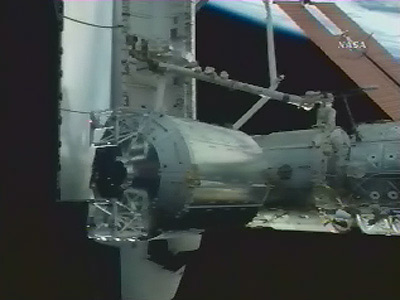Astronauts to Outfit Station's New Lab for Science

HOUSTON — A pair of spacewalking astronauts will outfit the International Space Station's (ISS) new Columbus laboratory for science Friday when they add new experiments to the module's orbital porch.
Atlantis shuttle astronauts Rex Walheim and Stanley Love will step outside the station's Quest airlock at 8:40 a.m. EST (1340 GMT) to attach two European research platforms aimed at studying the sun and space environment.
"First will be SOLAR, which is a solar telescope that mounts to the outside of Columbus," Love said in a NASA interview.
Equipped with three separate instruments, SOLAR is a two-year experiment to study the sun across a variety of wavelengths and monitor the interactions of solar weather with the Earth's atmosphere.
Love will attach the bulky experiment to the upper of two available platforms on Columbus' outboard end while perched at the tip of the station's crane-like Canadarm2 robotic arm.
"I like to joke that I am the 'meat end effector,'" Love said in a NASA interview. "I am the thing on the arm that grabs things."
In fact, Love will spend most of today's planned 6 1/2-hour spacewalk — the third of NASA's STS-122 mission — at the end of the station's robotic arm moving refrigerator-sized experiments to and from the cargo bay of Atlantis.
Get the Space.com Newsletter
Breaking space news, the latest updates on rocket launches, skywatching events and more!
"Stan's going to have quite the arm rides around taking these payloads back and forth," said Walheim, who will also install new handrails outside Columbus.
Shuttle astronaut Leland Melvin and ISS flight engineer Leopold Eyharts, a French astronaut representing the ESA, will control the 57-foot (17-meter) Canadarm2 robotic arm from inside the station. Shuttle pilot Alan Poindexter will choreograph the spacewalkers from inside Atlantis.
After installing SOLAR, Love and Walheim will retrieve a broken control moment gyroscope and stow in Atlantis to be returned to Earth. The U.S. gyroscope, one of four 600-pound (272-kg) flywheels used to orient the space station without firing Russian thrusters, has failed and was replaced by astronauts last year.
Once the gyroscope is stowed, Walheim and Love will retrieve the European Technology Exposure Facility (EuTEF), a 771-pound (350-kg) platform designed to hold up to nine separate instruments to monitor the space environment and test new materials.
"Basically, [it's] looking at how materials respond to being exposed to space for a long period of time," Love said.
If Love and Walheim have extra time left over, they may also test a tiny, 2-millimeter divot on a handrail near the station's U.S. airlock. Mission Control nicknamed the ding "Love Crater" and hope to learn whether it poses a tear risk for spacesuit gloves.
"One of the things we want to do is get some more photos of that to characterize it a little bit better," said ISS flight director Bob Dempsey.
Astronauts have also cobbled together a finger-like device that the spaceflyers will poke and rub against the damaged handrail to test its effect on spacesuit fabric, Dempsey said.
Walheim and Love may also inspect a balky gear designed to rotate the station's starboard solar arrays like a paddlewheel to track the sun. Metallic grit has contaminated the 10-foot (3-meter) wide gear and prevented its full rotation, though engineers remain puzzled as to the cause.
Commanded by veteran shuttle flyer Stephen Frick, Atlantis' STS-122 crew is in the midst of a 13-day mission to deliver the Columbus lab and Eyharts to the ISS. The astronauts are slated to return to Earth on Feb. 20.
NASA is broadcasting Atlantis' STS-122 mission live on NASA TV. Click here for SPACE.com's shuttle mission coverage and NASA TV feed.
Join our Space Forums to keep talking space on the latest missions, night sky and more! And if you have a news tip, correction or comment, let us know at: community@space.com.

Tariq is the Editor-in-Chief of Space.com and joined the team in 2001, first as an intern and staff writer, and later as an editor. He covers human spaceflight, exploration and space science, as well as skywatching and entertainment. He became Space.com's Managing Editor in 2009 and Editor-in-Chief in 2019. Before joining Space.com, Tariq was a staff reporter for The Los Angeles Times covering education and city beats in La Habra, Fullerton and Huntington Beach. In October 2022, Tariq received the Harry Kolcum Award for excellence in space reporting from the National Space Club Florida Committee. He is also an Eagle Scout (yes, he has the Space Exploration merit badge) and went to Space Camp four times as a kid and a fifth time as an adult. He has journalism degrees from the University of Southern California and New York University. You can find Tariq at Space.com and as the co-host to the This Week In Space podcast with space historian Rod Pyle on the TWiT network. To see his latest project, you can follow Tariq on Twitter @tariqjmalik.









